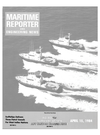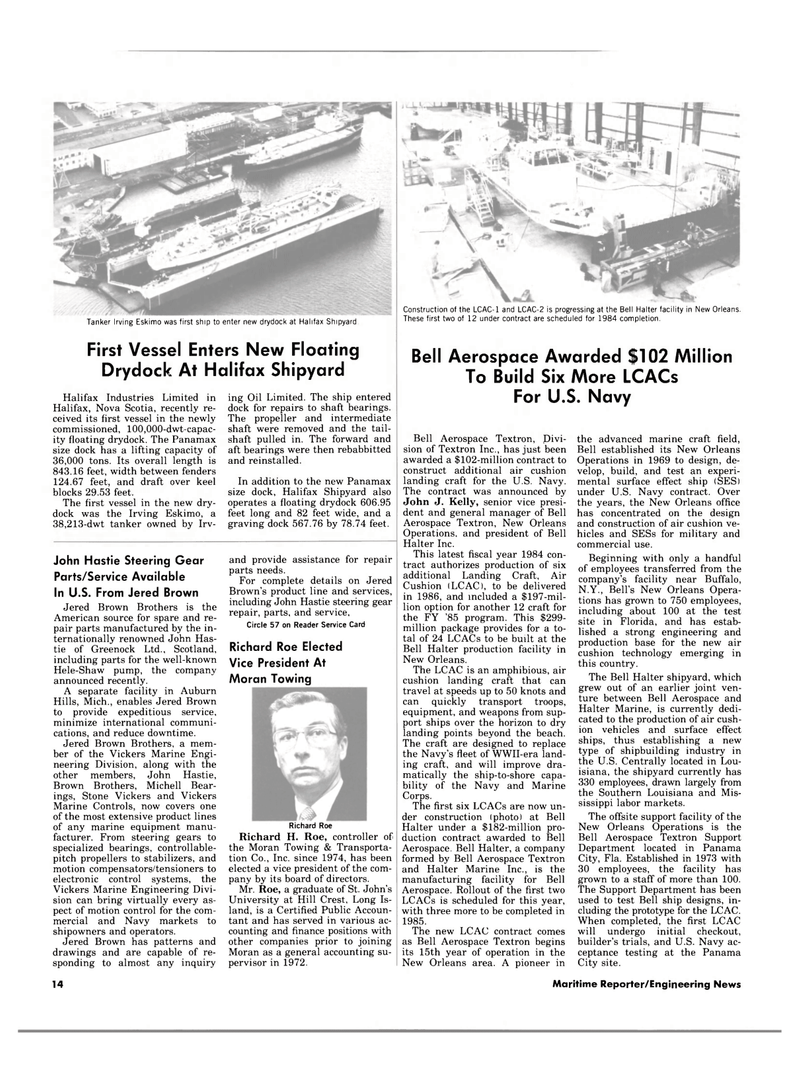
Page 12: of Maritime Reporter Magazine (April 15, 1984)
Read this page in Pdf, Flash or Html5 edition of April 15, 1984 Maritime Reporter Magazine
Tanker Irving Eskimo was first ship to enter new drydock at Halifax Shipyard
Construction of the LCAC-1 and LCAC-2 is progressing at the Bell Halter facility in New Orleans.
These first two of 12 under contract are scheduled for 1984 completion.
First Vessel Enters New Floating
Drydock At Halifax Shipyard Bell Aerospace Awarded $102 Million To Build Six More LCACs
For U.S. Navy Halifax Industries Limited in Halifax, Nova Scotia, recently re- ceived its first vessel in the newly commissioned, 100,000-dwt-capac- ity floating drydock. The Panamax size dock has a lifting capacity of 36,000 tons. Its overall length is 843.16 feet, width between fenders 124.67 feet, and draft over keel blocks 29.53 feet.
The first vessel in the new dry- dock was the Irving Eskimo, a 38,213-dwt tanker owned by Irv-
John Hastie Steering Gear
Parts/Service Available
In U.S. From Jered Brown
Jered Brown Brothers is the
American source for spare and re- pair parts manufactured by the in- ternationally renowned John Has- tie of Greenock Ltd., Scotland, including parts for the well-known
Hele-Shaw pump, the company announced recently.
A separate facility in Auburn
Hills, Mich., enables Jered Brown to provide expeditious service, minimize international communi- cations, and reduce downtime.
Jered Brown Brothers, a mem- ber of the Vickers Marine Engi- neering Division, along with the other members, John Hastie,
Brown Brothers, Michell Bear- ings, Stone Vickers and Vickers
Marine Controls, now covers one of the most extensive product lines of any marine equipment manu- facturer. From steering gears to specialized bearings, controllable- pitch propellers to stabilizers, and motion compensators/tensioners to electronic control systems, the
Vickers Marine Engineering Divi- sion can bring virtually every as- pect of motion control for the com- mercial and Navy markets to shipowners and operators.
Jered Brown has patterns and drawings and are capable of re- sponding to almost any inquiry ing Oil Limited. The ship entered dock for repairs to shaft bearings.
The propeller and intermediate shaft were removed and the tail- shaft pulled in. The forward and aft bearings were then rebabbitted and reinstalled.
In addition to the new Panamax size dock, Halifax Shipyard also operates a floating drydock 606.95 feet long and 82 feet wide, and a graving dock 567.76 by 78.74 feet. and provide assistance for repair parts needs.
For complete details on Jered
Brown's product line and services, including John Hastie steering gear repair, parts, and service.
Circle 57 on Reader Service Card
Richard Roe Elected
Vice President At
Moran Towing
Richard Roe
Richard H. Roe, controller of the Moran Towing & Transporta- tion Co., Inc. since 1974, has been elected a vice president of the com- pany by its board of directors.
Mr. Roe, a graduate of St. John's
University at Hill Crest, Long Is- land, is a Certified Public Accoun- tant and has served in various ac- counting and finance positions with other companies prior to joining
Moran as a general accounting su- pervisor in 1972.
Bell Aerospace Textron, Divi- sion of Textron Inc., has just been awarded a $102-million contract to construct additional air cushion landing craft for the U.S. Navy.
The contract was announced by
John J. Kelly, senior vice presi- dent and general manager of Bell
Aerospace Textron, New Orleans
Operations, and president of Bell
Halter Inc.
This latest fiscal year 1984 con- tract authorizes production of six additional Landing Craft, Air
Cushion (LCAC), to be delivered in 1986, and included a $197-mil- lion option for another 12 craft for the FY '85 program. This $299- million package provides for a to- tal of 24 LCACs to be built at the
Bell Halter production facility in
New Orleans.
The LCAC is an amphibious, air cushion landing craft that can travel at speeds up to 50 knots and can quickly transport troops, equipment, and weapons from sup- port ships over the horizon to dry landing points beyond the beach.
The craft are designed to replace the Navy's fleet of WWII-era land- ing craft, and will improve dra- matically the ship-to-shore capa- bility of the Navy and Marine
Corps.
The first six LCACs are now un- der construction (photo) at Bell
Halter under a $182-million pro- duction contract awarded to Bell
Aerospace. Bell Halter, a company formed by Bell Aerospace Textron and Halter Marine Inc., is the manufacturing facility for Bell
Aerospace. Rollout of the first two
LCACs is scheduled for this year, with three more to be completed in 1985.
The new LCAC contract comes as Bell Aerospace Textron begins its 15th year of operation in the
New Orleans area. A pioneer in the advanced marine craft field,
Bell established its New Orleans
Operations in 1969 to design, de- velop, build, and test an experi- mental surface effect ship (SES) under U.S. Navy contract. Over the years, the New Orleans office has concentrated on the design and construction of air cushion ve- hicles and SESs for military and commercial use.
Beginning with only a handful of employees transferred from the company's facility near Buffalo,
N.Y., Bell's New Orleans Opera- tions has grown to 750 employees, including about 100 at the test site in Florida, and has estab- lished a strong engineering and production base for the new air cushion technology emerging in this country.
The Bell Halter shipyard, which grew out of an earlier joint ven- ture between Bell Aerospace and
Halter Marine, is currently dedi- cated to the production of air cush- ion vehicles and surface effect ships, thus establishing a new type of shipbuilding industry in the U.S. Centrally located in Lou- isiana, the shipyard currently has 330 employees, drawn largely from the Southern Louisiana and Mis- sissippi labor markets.
The offsite support facility of the
New Orleans Operations is the
Bell Aerospace Textron Support
Department located in Panama
City, Fla. Established in 1973 with 30 employees, the facility has grown to a staff of more than 100.
The Support Department has been used to test Bell ship designs, in- cluding the prototype for the LCAC.
When completed, the first LCAC will undergo initial checkout, builder's trials, and U.S. Navy ac- ceptance testing at the Panama
City site. 14 Maritime Reporter/Engineering News

 11
11

 13
13
